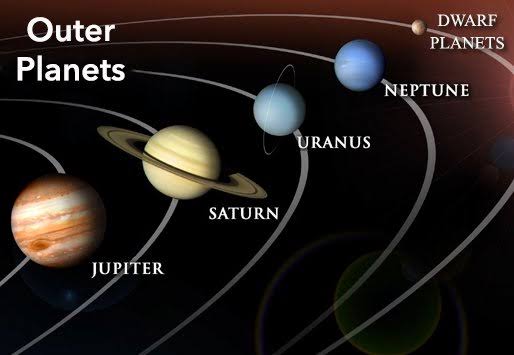Outer Planets – General Science Notes – For W.B.C.S. Examination.
Our solar system consists of eight planets, one sun, one dwarf planet, an asteroid belt, and many moons. The sun is in the middle of our solar system. Next come Mercury, Venus, Earth, and Mars. These are the small and rocky inner planets known as the terrestrial planets.Continue Reading Outer Planets – General Science Notes – For W.B.C.S. Examination.
After Mars, there is an asteroid belt that separates the inner planets from the outer ones. The outer planets are called the jovian planets, meaning huge gas giant. These planets in order are Jupiter, Saturn, Uranus, and Neptune. Pluto comes after Neptune, but it is no longer considered a planet. It is now a dwarf planet.
The inner planets are rocky, sometimes all the way to their core. Gas giants are made mostly of gas with a non-gaseous core. Scientists haven’t been able to discover exactly what exists in the core of a gas giant. They believe it may be solid or made of liquid metal.Size is the most obvious difference between the inner and outer planets. The outer planets are huge! Our largest inner planet is Earth, and Earth is only 1/4 the size of the smallest outer planet, Neptune.
Jupiter
Jupiter is the first of the outer planets in order. It is also the biggest, with a mass that is more than all the other planets combined. Jupiter is so big that it often changes the trajectory of passing comets and thereby protects the inner planets from being hit by them.
Jupiter spins very fast on its axis, so one day there is short, only 10 Earth hours. But its year is quite long, nearly 12 Earth years.
Look out your window and check out those colorful bands. The pattern of wide and narrow bands you see are made of whirling clouds. Jupiter also has very faint rings and at least 50 moons – probably more! Wow! What a great place to visit.
Saturn
The next stop on our tour is Saturn. Most people know Saturn for its rings, which are the brightest rings in the solar system. Many people don’t know that Saturn is also a windy place, with winds at its equator that get up to 1100 miles per hour! Saturn also boasts 50 moons, including the largest moon in the solar system – Titan. Titan is bigger than the planet Mercury and is so large it has its own atmosphere.
A day on Saturn is 10 hours 39 minutes, and a year lasts 29.4 Earth years.
Uranus
Uranus looks different than the other planets, as you can see. It is tipped on its side. Scientists aren’t sure why it is tilted, but they think it may have been hit by a large object, possibly a planet, a long time ago that caused it to tilt. Another theory is that the gravity of its large moons is pulling it over to its side.
Uranus was discovered only 200 years ago, and it is hard for scientists to study because it is so far from Earth. Scientists do know it has narrow, dark rings, is four times the size of Earth, and has at least 27 moons.
The gas giants are made up primarily of hydrogen and helium, the same elements that make up most of the Sun. Astronomers think that hydrogen and helium gases comprised much of the solar system when it first formed. Since the inner planets didn’t have enough mass to hold on to these light gases, their hydrogen and helium floated away into space. The Sun and the massive outer planets had enough gravity to keep hydrogen and helium from drifting away.
The Sideways Planet
Most of the planets in the solar system rotate on their axes in the same direction that they move around the Sun. Uranus, though, is tilted on its side so its axis is almost parallel to its orbit. In other words, it rotates like a top that was turned so that it was spinning parallel to the floor. Scientists think that Uranus was probably knocked over by a collision with another planet-sized object billions of years ago.
Please subscribe here to get all future updates on this post/page/category/website


 +919674493673
+919674493673  mailus@wbcsmadeeasy.in
mailus@wbcsmadeeasy.in







































































































